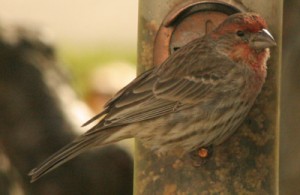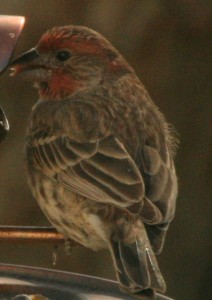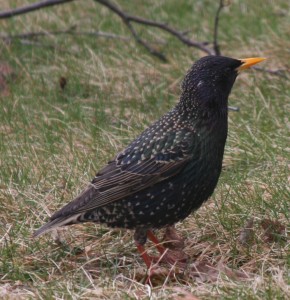Category Archives: Wildlife
Inca Dove – Columbina Inca
White-crowned Sparrow – Zonotrichia leucophrys
White-crowned Sparrow
General: I set a feeder up in front of a window in a garden close to the house and was surprised to see a White-crowned Sparrow scurrying through the brush borders. After research I found that their presence would be short lived since they were migrating north into Canada. After doing research I found this is a flocking bird and seeing a flock is common.(2) This is a stunning bird with really distinct markings.
 White-crowned Sparrows will share their territories with Fox Sparrows, but chase Chipping Sparrows and Dark-eyed Juncos until they leave. (1)
White-crowned Sparrows will share their territories with Fox Sparrows, but chase Chipping Sparrows and Dark-eyed Juncos until they leave. (1)
The White-Crowned Sparrow migrates across northern Canada and the western United States where it breeds. They nest either low in bushes or on the ground under shrubs. Females build nests out of twigs, coarse grasses, pine needles, moss, bark, and dead leaves. The female lays 3–7 pale green eggs spotted with brown. Incubation is 10 – 14 days. The chicks are born with sparse down feathers with closed eyes. They fledge in 8 – 10 days.
 Identification: The White-crowned Sparrow is a large sparrow with a small bill and a long tail. White-Crowned Sparrows are approximately 5.9”–6.3” long and have a wingspan of about 8”-9.5”. They weigh between .8 – 1 oz. The head can look distinctly peaked or smooth and flat, depending on the bird’s attitude. The White-Crowned Sparrow has a black-and-white head, pale beak (pink or yellow), and crisp gray breast. The wings are brown with bars and the under-parts are grey. They are similar in appearance to the White-throated Sparrow but do not have the white throat markings or yellow marking on head.
Identification: The White-crowned Sparrow is a large sparrow with a small bill and a long tail. White-Crowned Sparrows are approximately 5.9”–6.3” long and have a wingspan of about 8”-9.5”. They weigh between .8 – 1 oz. The head can look distinctly peaked or smooth and flat, depending on the bird’s attitude. The White-Crowned Sparrow has a black-and-white head, pale beak (pink or yellow), and crisp gray breast. The wings are brown with bars and the under-parts are grey. They are similar in appearance to the White-throated Sparrow but do not have the white throat markings or yellow marking on head.
Habitat: Look for White-crowned Sparrows in places where safe tangles of brush mix with open or grassy ground for foraging. For much of the United States, White-crowned Sparrows are most likely in winter (although two races live year round in the West, along the coast and in the mountains). (1)
Territory: Depending on time of year (see migration below) they are residents or transients in much of the US and Canada.
 Migration: White-Crowned Sparrows migrate north to Alaska and northern Canada – from Manitoba to Newfoundland and into the western US mountain Areas (Washington and Oregon) in the spring. Their southern migration in the fall is to Southern US from Gulf States through to California north to New Jersey. They are year round residents in New Mexico and Arizona.
Migration: White-Crowned Sparrows migrate north to Alaska and northern Canada – from Manitoba to Newfoundland and into the western US mountain Areas (Washington and Oregon) in the spring. Their southern migration in the fall is to Southern US from Gulf States through to California north to New Jersey. They are year round residents in New Mexico and Arizona.
Food: The majority of foods White-crowned Sparrows eat are seeds, grains, fruit and insects such as caterpillars, beetles and other insects. (2)
(1) Cornell University
Audubon Society Field Guide To North American Birds
Northern Cardinal – Cardinalis Cardinalis
General: According to The Audubon Society the Northern Cardinal was given its name because the deep red color of the males resemble the color of the robes of Roman Catholic Cardinals. Both sexes sing clear, song patterns, which are repeated several times, then varied. Some common songs are purdy-purdy-purdy, whoit-whoit-whoit and wheet-wheet-wheet.
 The female lays three to four eggs pale green eggs that are spotted red/brown in a cup shaped nest. Incubation takes 12 to 13 days. When hatched the chicks are naked except for sparse tufts of grayish down and eyes closed. Young fledge 10 to 11 days after hatching.
The female lays three to four eggs pale green eggs that are spotted red/brown in a cup shaped nest. Incubation takes 12 to 13 days. When hatched the chicks are naked except for sparse tufts of grayish down and eyes closed. Young fledge 10 to 11 days after hatching.
In the United States, the Northern Cardinal is the mascot of a number of athletic teams. In professional sports, it is the mascot of the St. Louis Cardinals of Major League Baseball and the Arizona Cardinals of the National Football League. In college athletics, it is the mascot of many schools, including the University of Louisville, the State University of New York at Plattsburgh, Ball State University, Illinois State University, Lamar University, the Catholic University of America, Wesleyan University, Wheeling Jesuit University, Massachusetts College of Pharmacy and Health Sciences, North Idaho College and Saint John Fisher College. It is also the state bird of seven states, more than any other species: North Carolina, West Virginia, Ohio, Illinois, Indiana, Kentucky, and Virginia.
 Identification: The Northern Cardinal is a mid-sized songbird that is 8” – 9“ long with a wing span of 10” – 12“. As can be seen from the pictures, the Northern Cardinal has a distinctive crest on the head and a mask on its face which is black in the male and gray in the female. The male is a brilliant crimson red with a black face mask over the eyes, extending to the upper chest. The color is dullest on the back and wings. The female is fawn, with mostly grayish-brown tones and a slight reddish tint on the wings, the crest, and the tail feathers.
Identification: The Northern Cardinal is a mid-sized songbird that is 8” – 9“ long with a wing span of 10” – 12“. As can be seen from the pictures, the Northern Cardinal has a distinctive crest on the head and a mask on its face which is black in the male and gray in the female. The male is a brilliant crimson red with a black face mask over the eyes, extending to the upper chest. The color is dullest on the back and wings. The female is fawn, with mostly grayish-brown tones and a slight reddish tint on the wings, the crest, and the tail feathers.
Young birds, both male and female, are similar to the adult female until the fall, when they molt and grow adult feathers.
 Habitat: The Northern Cardinal is found in woodlands, gardens, thickets, shrub-lands, and swamps. It is a common bird in suburbs and is a frequent visitor to backyard bird feeding stations.
Habitat: The Northern Cardinal is found in woodlands, gardens, thickets, shrub-lands, and swamps. It is a common bird in suburbs and is a frequent visitor to backyard bird feeding stations.
Territory: It can be found in southern Canada – Ontario, Quebec, and Nova Scotia and east, through the eastern United States from Maine to Texas and south through Mexico.
Migration: Cardinals are year round residents and really don’t have formal migratory patterns.
Food: Cardinals primarily eat seeds, grains, and fruits, however; they do eat insects to a lesser extent. Parent birds feed nestlings mostly insects.
House Finch – Carpodacus Mexicanus
House Finch
General:
The House Finch was originally an inhabitant to the west coast of the U.S. and Mexico but has been introduced to the east coast. According to Audubon, in the 1940’s caged House Finches were released in New York City and Long Island, New York. Since that time, the House Finch has established new territory along the Atlantic coast. House Finches were introduced to Oahu from San Francisco sometime before 1870. They had become abundant on all the major Hawaiian Islands by 1901. As with all such events, unintended consequences have occurred. Competition for food and habitat resulted in East coast populations of native Purple Finch and the invasive House Sparrow to decline. (1)
 With its increased territory and adaptability, the total House Finch population across North America is estimated between 267 million and 1.4 billion individuals. (2)
With its increased territory and adaptability, the total House Finch population across North America is estimated between 267 million and 1.4 billion individuals. (2)
House Finches nest in many different places from man-made structures to trees to rock ledges. They will use abandoned nests of other birds. Overall width of the nest is 3-7 inches, with the inside cup 1-3 inches across and up to 2 inches deep.
 The female lays 2 to 6 pale blue to white eggs speckled with fine black and pale purple markings. The eggs are about .6” long and ½” wide. The chicks hatch in 13 to 14 days and are naked except for sparse white down along feather tracts. They fledge in 12 to 19 days.
The female lays 2 to 6 pale blue to white eggs speckled with fine black and pale purple markings. The eggs are about .6” long and ½” wide. The chicks hatch in 13 to 14 days and are naked except for sparse white down along feather tracts. They fledge in 12 to 19 days.
House Finches can have two or more broods per year.
In captivity House Finches have lived as long as 11 years.
Identification:
House Finches are about the same size as House Sparrows but more slender. They measure 5.1” – 5.5” long and with a wingspan between 7.9” – 9.8”. They weigh ½ oz – 1 oz.
Adult males are rosy red around the face and upper breast, with streaky brown back, belly and tail. Adult females are plain grayish-brown with thick, blurry streaks and an indistinctly marked face.
The red of a male House Finch comes from pigments contained in its food. Because of this, sometimes orange or yellowish male House Finches will be observed.
Habitat:
House Finches inhabit city parks, backyards, urban centers, farms, and forest edges across the continent. In the western U.S., House Finches native habitat is desert, grassland and open woods. They are frequent late fall and winter visitors to my upstate NY backyard birdfeeder.
Territory:
Native range was west coast from Mexico to Canada east to Texas and Nebraska. The east coast population is north to Maine and Canada south to Florida and west to the Mississippi. (3)
Migration:
These birds are mainly permanent residents; some eastern birds migrate south.
Diet:
House Finches eat almost exclusively plant materials, seeds, buds and fruits. In orchards, House Finches eat cherries, apricots, peaches, pears, plums, strawberries, blackberries, and figs.
1. Wootton, JT. (1987). “Interspecific Competition between Introduced House Finch Populations and Two Associated Passerine Species”. pages 325–331.
3. Belthoff, James R.; Gauthreaux, Sidney A. (1991). “Partial Migration and Differential Winter Distribution of House Finches in the Eastern United States”
Common Starling – Sturnus vulgaris
Common Starling
General:
The Common Starling, European Starling, is native to most of temperate Europe and western Asia. It was introduced into the New York in 1890 when only 100 birds were released. (1) Since then they have spread throughout the US and Canada. Large flocks of Starlings (easily made up of thousands of birds) can be seen in farm areas in upstate NY. This has proven to be both beneficial and detrimental at the same time. They do eat many crop damaging insects yet they also eat grain seeds and have replaced native species. Frankly, I believe this a classic example of the unintended consequence of introducing an “invasive species”.
 The breeding season begins in early spring and summer. Males choose the nest site and use it to attract females. (2) I have had numerous issues with Starlings becoming stuck in vent grates and have friends that had them entering the house via the fireplace. Starlings also occasionally nest in burrows and cliffs. The female lays 3 to 6 light blue – green/white eggs. The incubation period is approximately 12 days. The chicks are helpless when hatched. They fledge in approximately another 21 days. Pairs may have three broods per breeding season.
The breeding season begins in early spring and summer. Males choose the nest site and use it to attract females. (2) I have had numerous issues with Starlings becoming stuck in vent grates and have friends that had them entering the house via the fireplace. Starlings also occasionally nest in burrows and cliffs. The female lays 3 to 6 light blue – green/white eggs. The incubation period is approximately 12 days. The chicks are helpless when hatched. They fledge in approximately another 21 days. Pairs may have three broods per breeding season.
The Common Starling is a great vocal mimic: individuals can learn the calls of up to 20 different species. Their normal calls are rather raspy calls with no real rhythm.
As a note – in NY there is no closed hunting season on Starlings (at least now).
 Identification: Starlings are chunky and blackbird-sized they are 8”–9” long with a wingspan of approximately 13”-16”. They weigh between 2–4 oz. The bill is narrow conical with a sharp tip. In flight their wings are short and pointed as are their tails. At a distance, starlings look black. In summer they are purplish-green iridescent with yellow beaks; in fresh winter plumage they are brown, covered in white spots. Their legs are stout and as can be seen are pink/red.
Identification: Starlings are chunky and blackbird-sized they are 8”–9” long with a wingspan of approximately 13”-16”. They weigh between 2–4 oz. The bill is narrow conical with a sharp tip. In flight their wings are short and pointed as are their tails. At a distance, starlings look black. In summer they are purplish-green iridescent with yellow beaks; in fresh winter plumage they are brown, covered in white spots. Their legs are stout and as can be seen are pink/red.
Juveniles are grey-brown, and by their first winter resemble adults though often retain some brown juvenile feathering especially on the head in the early part of the winter.
Habitat:
European Starlings prefer urban or suburban areas. They also commonly reside in grassy areas such as farmland, grazing pastures, open forests and woodlands.
Territory:
Starling range from Alaska, through much of Canada, all the contiguous US.
Migration:
Starlings do not engage in any significant migration.
Food:
Starlings are omnivorous but they eat mostly insects and other invertebrates such as grasshoppers, beetles, flies, caterpillars, snails, earthworms, millipedes, and spiders. They also eat fruits and grains and will frequent bird feeders.
(1) The Audubon Society Field Guide to North American Birds





